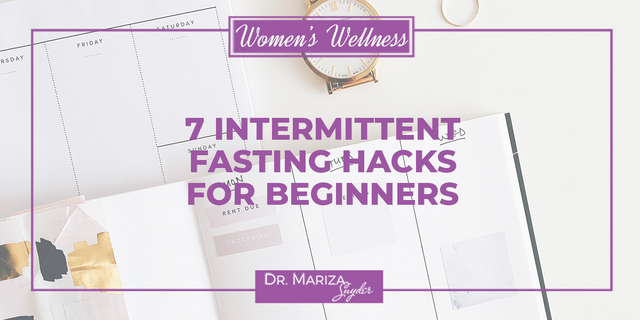
With hormonal changes, weight fluctuations, menopause, and more– you may have heard that women just shouldn’t even bother with intermittent fasting.
Well… that’s not really the truth.
It’s time to debunk this myth, and uncover the incredible benefits you can feel when doing intermittent fasting right!
Certain forms of intermittent fasting may be too restrictive on your body, especially as women. But there are ways to intermittent fast to boost your metabolism and improve your wellness – that are safe and easy for women.
I was an intermittent fasting beginner once too, and there were definitely some hurdles I faced when figuring out exactly how to do it right.
But after years of sticking to my favorite intermittent fasting method for women, I’ve felt the results in my body, and I’ve never looked back!
If I can do it, I know you can too.
Now, I want to teach YOU the top hacks for intermittent fasting beginners. So you can harness massive benefits for your body and overall health.
What to Expect When Intermittent Fasting Is Done Right
There are numerous positive outcomes you can experience with intermittent fasting.
Some key benefits of intermittent fasting include:
- Increased metabolic flexibility
- More energy
- Reduced belly fat
- Lean body mass
- Improved concentration
- Better sleep
Intermittent fasting also can create positive changes in the functioning of hormones, cells, and genes in women.
It’s shown to reduce stress and inflammation in the body– which are common precursors to chronic disease.
So, staying consistent with intermittent fasting can even extend your lifespan.
With so many benefits, there’s no reason not to try intermittent fasting!
The Two Best Approaches to Intermittent Fasting for Women Over 35
The two best types of intermittent fasting for women go hand in hand. And both are great options when just starting out with intermittent fasting.
These two types are circadian-based fasting and early time-restricted eating.
Circadian-Based Fasting
Circadian-based fasting aligns meal timing with the body’s internal clock and cortisol fluctuations. This style of intermittent fasting works exactly how it sounds— you fast in tune with your circadian rhythm.
This means eating your meals while the sun is up and fasting while the sun is down.
Your body naturally cycles through hormonal and physical changes depending on the time of day it is. So eating in tune with these changes is how you can get optimal results– and fast.
A Circadian-based fasting day may look like this:
- Wake up with the sunrise by 7:30 am
- Eat a balanced breakfast shortly after
- Eat throughout the day with a protein-packed lunch
- Have a healthy dinner as your last meal of the day by 8 pm or before sunset
Early Time-Restricted Eating
Early time-restricted eating is a flexible approach to intermittent fasting, but it’s slightly different that circadian-based.
With early time-restricted eating, you still eat while the sun is up and fast while the sun is down. However, this method emphasizes shifting your timing of meals to earlier in the day.
This means you may wake up and eat right away at sunrise, but then consume your final meal of the day by 4 to 5 pm.
Eating a healthy, balanced breakfast is highly important with this method, so you aren’t saving your biggest meal for the end of the day.
An Early Time-Restricted Eating day may look like this:
- Wake up with the sunrise by 7:30
- Eat a healthy, protein-packed, balanced breakfast shortly after
- Have a hearty lunch around mid-day
- Eat a simple, balanced meal for dinner by 5 pm– with no additional food after!
Intermittent Fasting and Women’s Hormonal Changes
Intermittent fasting can greatly impact a woman’s hormone-related issues.
It can decrease your estrogen levels, so adapting your fasting patterns during different phases of the menstrual cycle can be beneficial in regulating this balance, and easing menstrual symptoms.
There are 4 phases of your menstrual cycle: the menstrual, follicular, ovulatory, and luteal.
Your body is likely better equipt to handle longer fasting periods in the middle of your cycle, towards the ovulatory phase.
And when you’re menstruating, focus on cutting back your fasting window so you have plenty of time to rest and nourish your body.
The main thing when trying anything new– especially as women with our body’s hormonal fluctuations– is to listen to the needs of your body.
My 7 Key Hacks for Intermittent Fasting Beginners
Ready to start fasting? Here are my top 7 hacks for intermittent fasting beginners to commit to for success with intermittent fasting.
1. Ease Into Intermittent Fasting
Ease into fasting with a 12:12 fast. This means eating for 12 hours of the day and fasting for the other 12. Typical 12:12 schedules are 7 am to 7 pm or 8 am to 8 pm.
See what works for you, then gradually extend your fasting time to between 14 and 16 hours. I usually eat from 8 am until 5 or 6 pm, keeping me closer to 14-15 hour fasting days.
2. Time Your Dinners Strategically
Strategically time your dinner earlier for better metabolic outcomes.
Eating a healthy, balanced dinner with protein early in the evening gives your body plenty of time to digest– and allows your blood sugar to regulate– before going to bed.
I shoot for 3 hours between my last meal and bedtime.
3. Don’t Skimp on Protein!
Emphasize protein-rich, low-sugar dinners! Eating filling meals will help to curb late-night cravings. But make sure you don’t have empty calories or added sugars.
This will send your body on a blood sugar roller coaster later in the day– affecting your sleep and your metabolic functioning.
4. Build Balanced Breakfasts
Plan for a nourishing, nutrient-dense breakfast to kickstart your day. It’s crucial to get protein in your breakfasts! Don’t just grab a banana on the go.
My ideal breakfasts have key proteins like eggs, all-natural peanut butter, or a protein-powder smoothie. Make sure to get fiber, protein, and healthy fats in!
Try a 2 egg omelet with spinach and avocado in the morning. You’ll feel energized for the day to come!
5. Quit Snacking!
Remove snacking– especially late at night– to stabilize blood sugar levels.
If you’re prioritizing healthy, balanced meals, you should be able to minimize or eliminate snacking altogether.
- Stay Committed
Commit to at least two weeks of intermittent fasting.
Sticking to your schedule will help you overcome cravings and adapt to your new intermittent fasting method.
7. Listen to Your Body and Its Needs
Stay in tune with your body’s signals and adjust your fasting patterns accordingly.
It’s not a race, and you can take as long as your body needs to start lengthening your fasting window!
The Bottom Line
Intermittent fasting can greatly benefit women when done correctly– improving metabolism, energy, weight loss, and overall health.
Circadian-based and early time-restricted fasting are both effective approaches for women when starting out with intermittent fasting.
Don’t forget– my 7 key hacks for intermittent fasting beginners are:
- Ease into it
- Time your dinners
- Protein, protein, protein!
- Build balanced breakfasts
- No snacking
- Stay committed
- And listen to your body
When you follow these steps, I promise intermittent fasting won’t seem like such a hurdle to overcome.
Stay in tune with your body, and don’t put pressure on yourself. I know if you commit to starting intermittent fasting, it can become a way of life.
Plus, if you want the BEST intermittent fasting protocol for women over 35, check out my
This course is designed to boost your energy, get rid of brain fog, and help you on your journey to become your healthiest self at any age.
But in the meantime, I encourage you to embrace these 7 strategies to gradually unlock the benefits of intermittent fasting!


No comments yet.